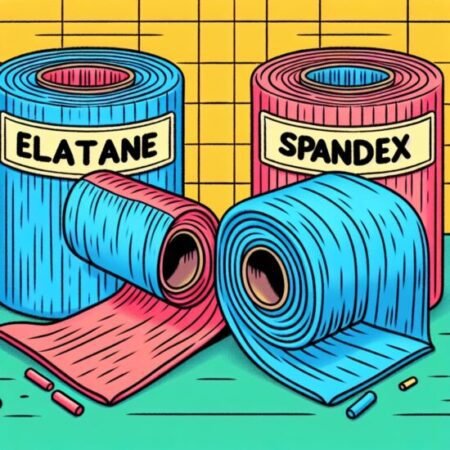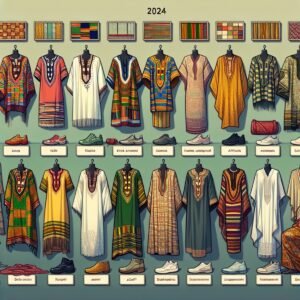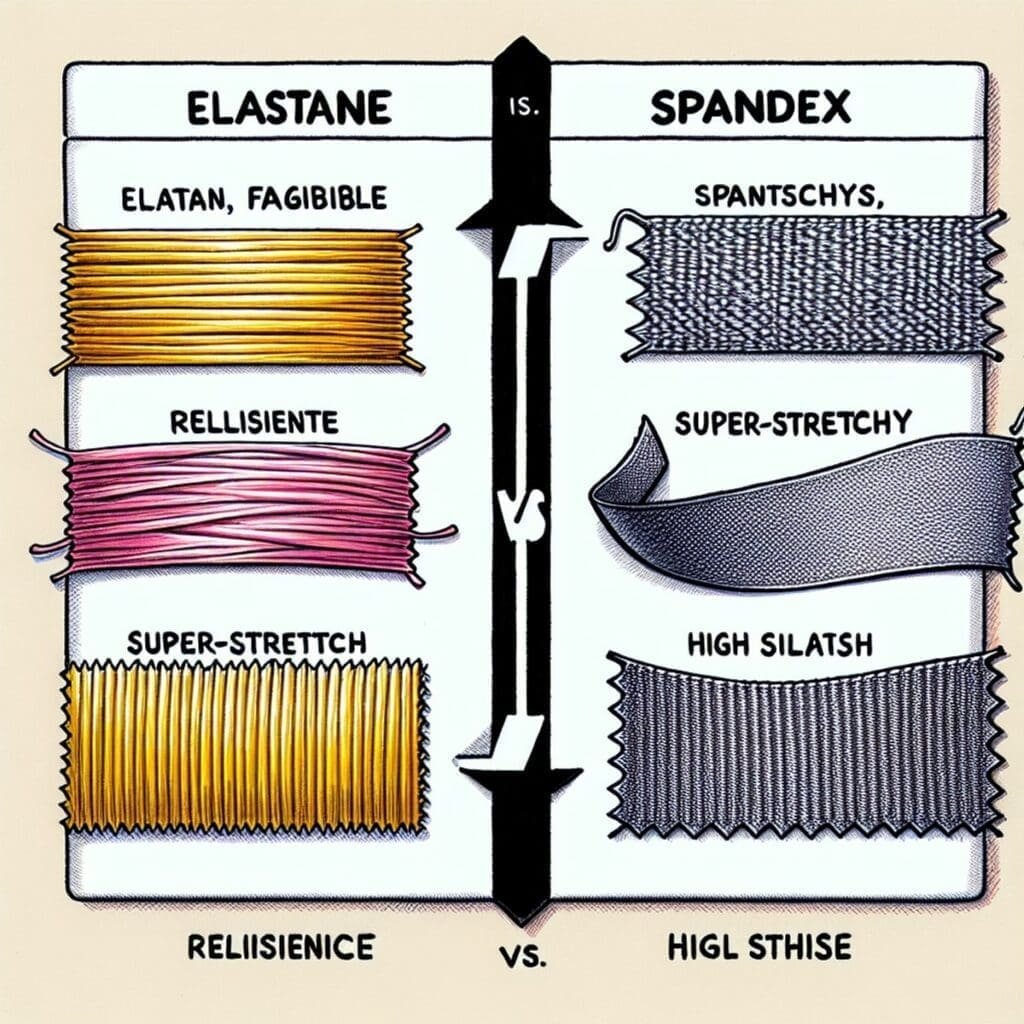
Introduction Elastane vs Spandex
Elastane and Spandex, although often used interchangeably, have subtle differences that set them apart. These synthetic fabrics are renowned for their stretch properties and are integral to the textile industry. Elastane, also known as Spandex or Lycra, is a critical component in various garments, including activewear, lingerie, and denim. However, the production and disposal of these materials raise significant sustainability concerns.
Brief Explanation of Elastane and Spandex
- Elastane and Spandex are synthetic fabrics known for their exceptional elasticity and stretch capabilities.
- They are commonly incorporated into a wide range of clothing to provide comfort and flexibility.
Key Takeaway
Although Elastane and Spandex are often used interchangeably, there are some nuances that set them apart, which we will explore in this article.
Significance in the Textile Industry
Elastane and Spandex play a vital role in modern fashion, enabling the creation of form-fitting and comfortable clothing across various categories.
Sustainability Concerns
The production and disposal of Elastane and Spandex raise notable environmental apprehensions due to significant energy consumption, water usage, and the employment of potentially harmful chemicals.
This article aims to delve deeper into the composition, branding history, applications in different industries, sustainability challenges, ongoing innovations, and responsible disposal practices associated with these materials.
Composition and Properties
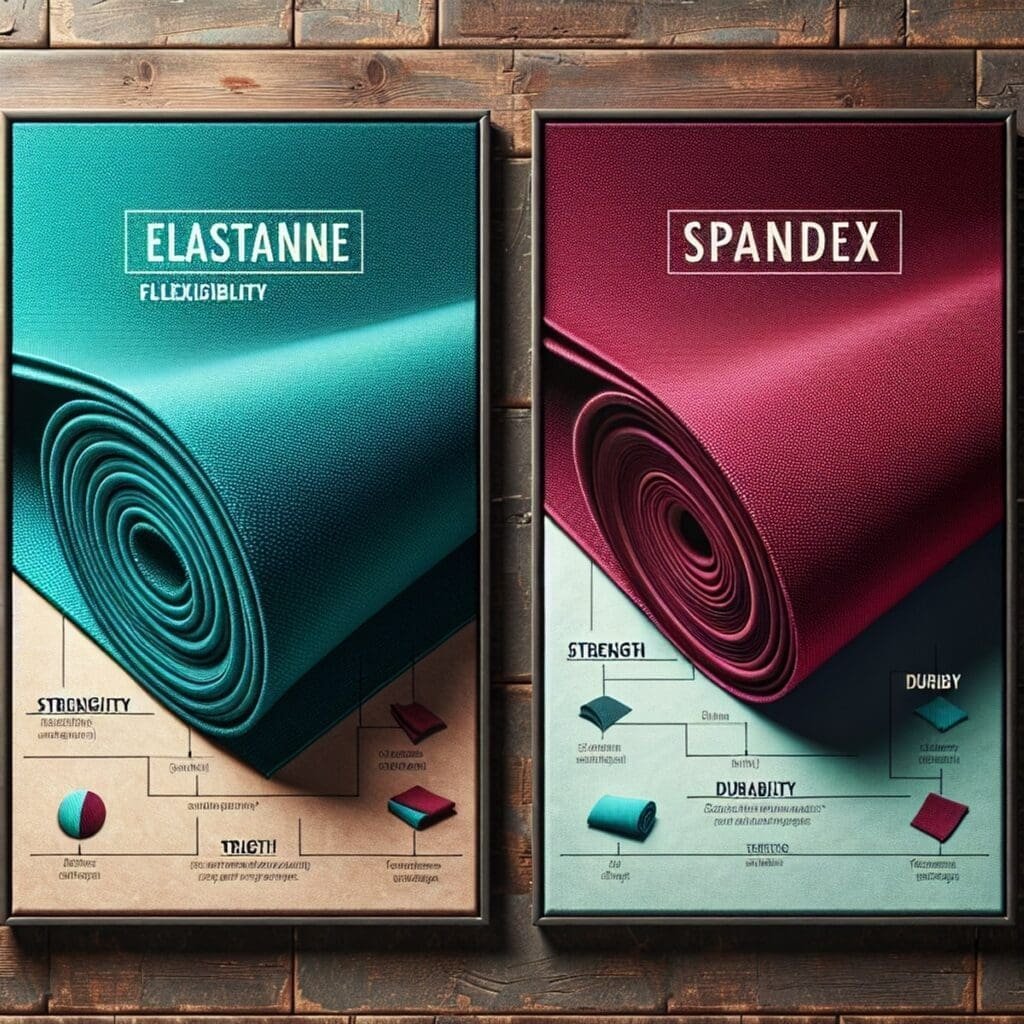
Elastane and Spandex are essentially the same synthetic material, known for their remarkable stretchiness and durability. Here’s a closer look at their composition and properties:
1. Similar Composition
Both Elastane and Spandex fibers are composed of a polyether-polyurea copolymer, with Elastane being the generic term used globally, while Spandex is the specific brand name often used in the United States.
2. Stretch and Recovery Properties
These fibers contribute to the stretch and recovery properties of fabrics, providing flexibility and comfort. Elastane offers exceptional stretch, allowing garments to retain their shape even after extensive wear, while Spandex is renowned for its ability to recover well after stretching.
3. Mechanical Properties
When it comes to resilience and resistance to wear and tear, Elastane and Spandex exhibit similar mechanical properties. Both materials are lightweight yet durable, making them ideal for various applications in the textile industry.
This comparison sheds light on the subtle differences between Elastane and Spandex, despite their interchangeable use in everyday language. Understanding these nuances is essential for making informed choices in fabric selection and production processes.
2. Understanding the Branding Dilemma
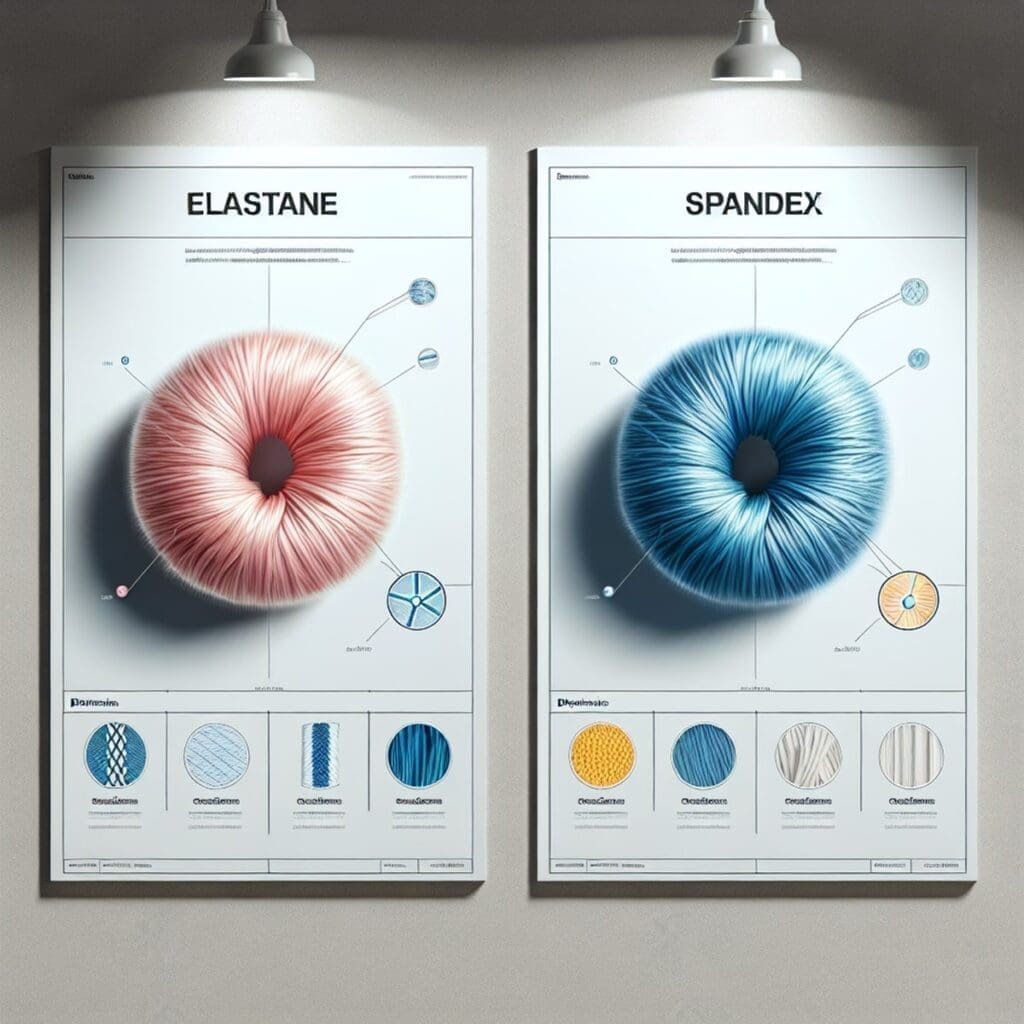
The branding history of Elastane, also known as Lycra, provides an interesting perspective on the term ‘Spandex’ in the US. The confusion between Elastane and Spandex arises from their interchangeable usage in different regions.
In the United States, the term ‘Spandex’ is commonly used to refer to stretch fabrics, while ‘Lycra’ is recognized as a brand name for Elastane. This branding dilemma can be attributed to DuPont, a chemical company that first introduced Elastane fibers under the brand name Lycra in the mid-20th century. DuPont’s Lycra quickly gained popularity and became synonymous with stretch fabrics.
However, as other manufacturers started producing similar fibers, they needed a generic term to describe them. Thus, the term ‘Spandex’ was coined as a contraction of “expand” and “elastic.” Over time, ‘Spandex’ became widely adopted in the United States as a general term for elastomeric fibers with exceptional stretch and recovery properties.
It’s important to note that while Lycra is a specific brand of Elastane, Spandex has become a more common and generic term used by consumers in the US. This can lead to confusion when discussing these materials, especially when comparing products or researching their properties.
Understanding this branding dilemma is crucial when navigating the textile industry and discussing Elastane and Spandex. It highlights how brand names have influenced language usage and consumer perceptions over time. Moreover, it’s worth exploring the sustainability aspects of Lycra fabric as well as its role in the development of high-performance fibers for a comprehensive understanding of its impact on various industries.
3. Examining Their Applications in Different Industries
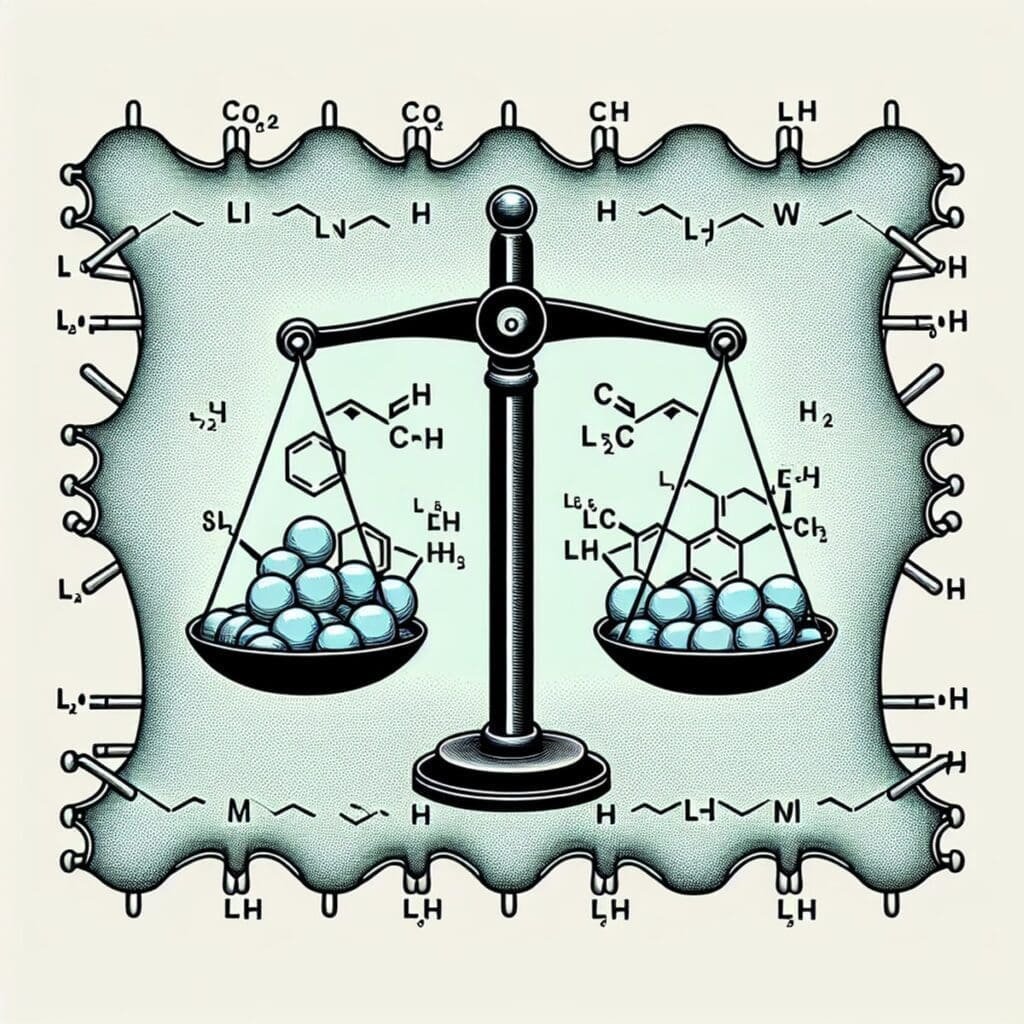
Elastane and Spandex have gained significant popularity in various industries due to their unique properties, especially their exceptional stretch and recovery capabilities. Let’s explore how these materials are utilized in different sectors:
Athletic Wear
Elastane/Spandex is widely used in the production of athletic wear for its flexibility and movement support features. The stretchability of these fabrics allows athletes to move freely and comfortably during physical activities. Whether it’s compression leggings, sports bras, or workout tops, Elastane/Spandex blends provide the necessary stretch for optimal performance.
Underwear and Bras
Elastane/Spandex is commonly used in intimate apparel like underwear and bras due to its ability to enhance fit and comfort. These fabrics offer a snug yet flexible fit, ensuring that undergarments stay in place without feeling constricting. The stretchiness of Elastane/Spandex allows for better contouring to the body, providing a seamless look under clothing.
Stretch Jeans
Elastane/Spandex blends are extensively utilized in the manufacturing of stretch jeans. These fabrics provide a figure-hugging silhouette while offering the flexibility and comfort desired in denim. By incorporating Elastane/Spandex into jeans, brands can create styles that adapt to different body shapes without sacrificing style or comfort.
The use of Elastane/Spandex in these industries highlights its versatility as a fabric component. Whether it’s enhancing performance in athletic wear or providing a comfortable fit in intimate apparel, Elastane/Spandex has become an essential ingredient for creating functional and fashionable garments.
By exploring these applications, we can see how Elastane/Spandex plays a crucial role in meeting the specific demands of different industries. Its unique properties contribute to the overall functionality and comfort of various clothing items.
However, it’s important to consider the sustainability concerns associated with the production and disposal of Elastane/Spandex, which we will discuss in the next section.
The Sustainability Debate: Balancing Performance with Environmental Impact
Elastane and Spandex are essential for making clothing stretchy and flexible. However, their production processes raise significant sustainability concerns.
Overview of Sustainability Challenges
The manufacturing of Elastane/Spandex involves:
- High energy consumption, which contributes to its environmental impact.
- Extensive use of water resources, raising concerns about water scarcity and environmental strain.
Energy Consumption and Water Resources
The production of Elastane/Spandex requires a lot of energy for making its components, spinning fibers, and even dyeing and finishing processes. This energy-intensive nature adds to its environmental footprint.
Additionally, the extraction and processing of raw materials for these fibers require a large volume of water, further exacerbating concerns about water scarcity and environmental strain.
Use of Harmful Chemicals
The production of Elastane/Spandex involves the use of potentially harmful chemicals, including solvents. If not managed properly, these chemicals can harm both the environment and human health.
These sustainability challenges associated with Elastane/Spandex highlight the need for:
- Innovation to develop more sustainable production methods.
- Collaborative efforts among stakeholders to drive systemic change within the fashion industry.
By working together, we can find solutions that reduce the environmental impact of Elastane/Spandex production while still maintaining their performance characteristics.”.
Innovations towards a More Sustainable Future
Efforts are underway to address the sustainability concerns associated with Elastane/Spandex production and find more eco-friendly alternatives. Researchers and manufacturers are exploring various innovations to create sustainable elastane fabrics that balance performance with reduced environmental impact. Some of the key developments in this area include:
1. Research and Development
Ongoing research and development efforts are focused on finding sustainable alternatives to conventional Elastane/Spandex. Scientists are working on developing new synthetic fibers that possess similar stretch and recovery properties while minimizing the use of energy-intensive processes and potentially harmful chemicals.
2. Incorporating Recycled Fibers
One promising approach is the incorporation of recycled fibers into elastane yarns. By utilizing recycled materials, the environmental footprint of elastane production can be significantly reduced. These recycled fibers may come from post-consumer waste, such as discarded garments or industrial waste from textile manufacturing processes.
3. Bio-based Materials
Another avenue for sustainable stretch fabrics involves the use of bio-based materials. Researchers are exploring the potential of plant-based sources, such as algae or agricultural by-products, to create elastane-like fibers that offer both performance and reduced environmental impact.
These innovations aim to provide consumers with more sustainable options without compromising on comfort, stretch, and durability. By incorporating recycled fibers and bio-based materials into elastane fabrics, the textile industry can take significant strides towards a more sustainable future.
It’s important to note that while these innovations hold promise, further research and development are needed to ensure their scalability and commercial viability. Collaboration between industry stakeholders, including manufacturers, researchers, and consumers, is crucial to drive innovation and accelerate the adoption of sustainable elastane fabrics.
Addressing the End-of-Life Conundrum
Elastane and Spandex-blended garments pose a significant challenge when it comes to recycling due to their complex nature. The elastic properties of these fibers make them difficult to separate from other materials during the recycling process. As a result, most recycling facilities are not equipped to handle elastane-containing garments, leading to them being discarded as waste.
To address this end-of-life conundrum, alternative options for responsible disposal can be considered:
- Donation: If your elastane-containing garments are still in good condition, consider donating them to charitable organizations or clothing drives. This way, someone else can benefit from their use, extending their lifespan and reducing waste.
- Upcycling projects: Get creative and repurpose your elastane garments into new items. For example, you can transform old leggings into headbands or use the fabric to make reusable shopping bags. Upcycling not only reduces waste but also allows you to give your clothing a second life.
While responsible disposal is important, efforts are also underway to develop innovative recycling technologies that can effectively handle elastane and Spandex-blended fabrics. Researchers are exploring methods such as chemical recycling and mechanical separation techniques to recover elastane fibers from blended materials.
By finding ways to recycle elastane-containing garments, we can reduce the environmental impact of these materials and contribute to a more sustainable textile industry. It is crucial for manufacturers, consumers, and policymakers to collaborate and invest in research and development efforts that focus on improving the recyclability of these fabrics.
Conclusion
- Encourage the exploration of more sustainable fabric choices that can meet our need for stretch and comfort without compromising the environment.
- Emphasize the importance of collaboration between industry stakeholders to drive innovation towards a truly sustainable future for Elastane and Spandex.
FAQs (Frequently Asked Questions)
What are Elastane and Spandex, and how do they differ?
Elastane and Spandex are both synthetic fabrics known for their stretchy properties. Although they are often used interchangeably, there are some nuances that set them apart. Elastane is the generic term used in most parts of the world, while Spandex is the term commonly used in the United States.
What are the mechanical properties of Elastane and Spandex?
Both Elastane and Spandex contribute to the stretch and recovery properties of fabrics, but they do so in slightly different ways. They have similar composition and provide stretchiness and durability, with differences in resilience and resistance to wear and tear.
What is the branding history of Elastane (Lycra) and its relation to the term ‘Spandex’?
Elastane is known as Lycra in the branding history, which has a strong association with the term ‘Spandex’ in the US. The use of these terms varies by region, leading to some confusion about their differences.
In which industries are Elastane/Spandex commonly used?
Elastane/Spandex is popularly used in athletic wear for its flexibility and movement support features. It is also commonly found in intimate apparel like underwear and bras for enhanced fit and comfort, as well as in stretch jeans for a figure-hugging silhouette.
What are the sustainability challenges associated with Elastane/Spandex production?
The production of Elastane/Spandex poses significant sustainability challenges, including high energy consumption, water resources usage, and potential use of toxic chemicals such as solvents.
What are some innovations towards a more sustainable future for Elastane/Spandex?
Ongoing research and development efforts are focused on creating sustainable alternatives to conventional Elastane/Spandex. This includes incorporating recycled fibers into elastane yarns and exploring bio-based materials as promising avenues for sustainable stretch fabrics.
How can garments containing Elastane/Spandex be responsibly disposed of?
Garments containing Elastane/Spandex present challenges for recycling due to their complex nature. Alternative options for responsible disposal include donation or upcycling projects to minimize environmental impact.
What is the conclusion regarding the use of Elastane vs Spandex and their impact on sustainability?
The conclusion emphasizes the need to explore more sustainable fabric choices that can meet our need for stretch and comfort without compromising the environment. It also calls for collaboration between industry stakeholders to drive innovation towards a truly sustainable future for Elastane and Spandex.
